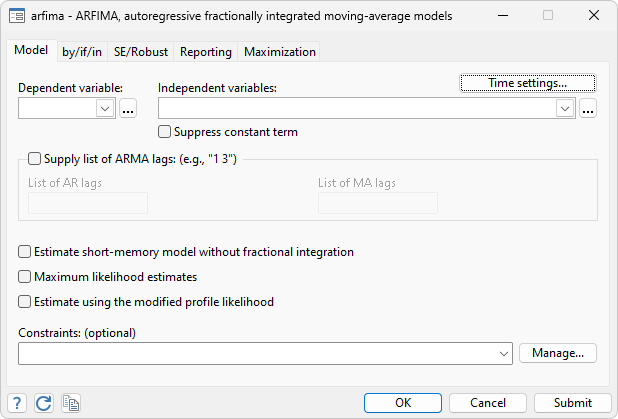2025 Stata Conference • Nashville, TN • 31 July–01 August
ARFIMA stands for AutoRegressive Fractionally Integrated Moving Average.
Stata fits ARFIMA models.
ARFIMA concerns long-memory processes. Long-memory processes are stationary processes whose autocorrelation functions decay slowly. The ARFIMA model provides a parsimonious parameterization of long-memory processes that nests the ARMA (autoregressive moving-average) model, which is widely used for short-memory processes. Long-memory processes can be obtained by fractionally integrating short-memory processes. The ARFIMA model does that. The ARFIMA model also generalizes the ARIMA model by allowing for fractional degrees of integration.

Below we analyze yearly data on the widths of the rings of a tree. This one tree survived 5,000 years! In any case, larger widths represent good years for the tree and narrower widths represent harsh years. Below we estimate the parameters of an ARFIMA model with the fractional difference parameter and a constant. With only those parameters, we will account for the long memory of the process.
. webuse campito, clear
(Campito Mnt. tree ring data from 3435BC to 1969AD)
. arfima width, nolog
ARFIMA regression
Sample: -3435 thru 1969 Number of obs = 5,405
Wald chi2(1) = 1864.44
Log likelihood = -18907.279 Prob > chi2 = 0.0000
| width | Coefficient Std. err. z P>|z| [95% conf. interval] | |
| width | ||
| _cons | 44.01432 9.174317 4.80 0.000 26.03299 61.99565 | |
| ARFIMA | ||
| d | .4468887 .0103497 43.18 0.000 .4266038 .4671737 | |
| /sigma2 | 63.92927 1.229754 51.99 0.000 61.519 66.33955 | |
Below we plot the original series and the fractionally differenced component of the predicted series, which reflects the short-memory component of the process:
Explore more time-series features in Stata.
Learn
Free webinars
NetCourses
Classroom and web training
Organizational training
Video tutorials
Third-party courses
Web resources
Teaching with Stata
© Copyright 1996–2025 StataCorp LLC. All rights reserved.
×
We use cookies to ensure that we give you the best experience on our website—to enhance site navigation, to analyze usage, and to assist in our marketing efforts. By continuing to use our site, you consent to the storing of cookies on your device and agree to delivery of content, including web fonts and JavaScript, from third party web services.
Cookie Settings
Last updated: 16 November 2022
StataCorp LLC (StataCorp) strives to provide our users with exceptional products and services. To do so, we must collect personal information from you. This information is necessary to conduct business with our existing and potential customers. We collect and use this information only where we may legally do so. This policy explains what personal information we collect, how we use it, and what rights you have to that information.
These cookies are essential for our website to function and do not store any personally identifiable information. These cookies cannot be disabled.
This website uses cookies to provide you with a better user experience. A cookie is a small piece of data our website stores on a site visitor's hard drive and accesses each time you visit so we can improve your access to our site, better understand how you use our site, and serve you content that may be of interest to you. For instance, we store a cookie when you log in to our shopping cart so that we can maintain your shopping cart should you not complete checkout. These cookies do not directly store your personal information, but they do support the ability to uniquely identify your internet browser and device.
Please note: Clearing your browser cookies at any time will undo preferences saved here. The option selected here will apply only to the device you are currently using.